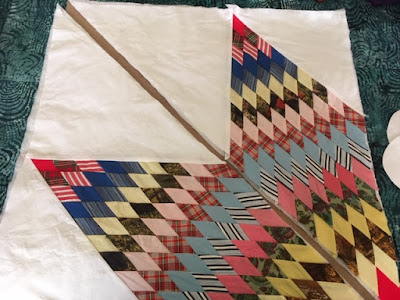Make quilting easy by doing individual sections on the sewing machine and then sewing them together.
This is the center section of a Lone Star quilt that was quilted in 8 sections and then sewn together and then the border will be quilted in sections and sewn together. The Lone Star was originally sewn by my friends' grandma in 1940 Alabama.
These are the sections before they were quilted.
There are 3 layers in each section. The backing, batting and top layer of fabric. These will be quilted through all layers.
I am arranging the quilting design in squares, so I am overlapping the seam of the triangles.
I am using a swirl design and layout the paper pattern over the whole square, leaving 1" margins on all sides.
Now I'll machine quilt around the circles, one triangle at a time.
I start at the top of the row and sew around the circle half way to were it intersects another circle, then turn and start stitching around the next circle, so it's like an hour glass.
When you get to the end of the row, stop within 1" of the edge and back tack.
This is what you will end up with to this point.
Then free hand sew a swirl in each circle or part circle, leaving a 1" margin on all edges.
Once each section is quilted, sew right sides together, attaching backing in seam for only 1 side of the seam. The other side will be hand stitched to close the seam.
Before closing the seam, first trim the batting close to the seam.
Then fold the seam allowance over and pin along length of seam.
Use a blind stitch and stitch length of seam. Continue attaching sections together in this manner. Once all sections are sewn together and quilt is complete, blind stitch the outer edges.

Because of the give in the fabric due to the pattern mostly cut on the bias, the lap quilting did not lay as flat as I would have liked and ultimately used one solid piece for the backing to support the structure of the quilt and had it machine quilted as one piece. It may have worked better if I used a walking foot.
The last picture shows a successful lap quilting project from the back which allows you to see the detail easily. I enjoyed this project and would use lap quilting any time I do a quilt except for the lone star quilt or any other quilt with a mostly bias cut pattern.


Because of the give in the fabric due to the pattern mostly cut on the bias, the lap quilting did not lay as flat as I would have liked and ultimately used one solid piece for the backing to support the structure of the quilt and had it machine quilted as one piece. It may have worked better if I used a walking foot.
The last picture shows a successful lap quilting project from the back which allows you to see the detail easily. I enjoyed this project and would use lap quilting any time I do a quilt except for the lone star quilt or any other quilt with a mostly bias cut pattern.



















